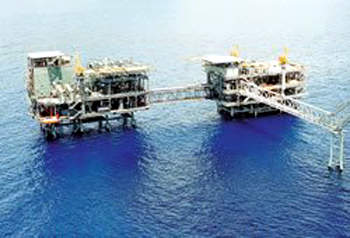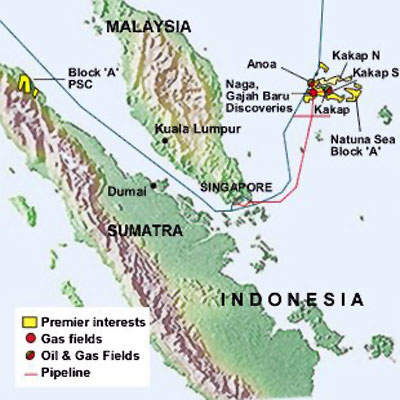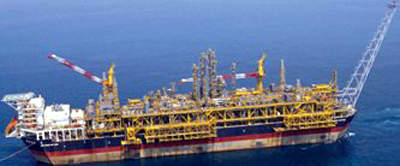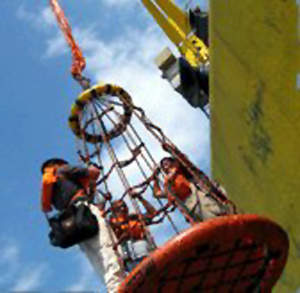Natuna gas field is in the Greater Sarawak Basin about 1,100km (700 miles) north of Jakarta and 225km (140 miles) northeast of the Natuna Islands, Indonesia’s northernmost territory in the South China sea.
Discovered in 1970 by Italy’s Agip, the field is the biggest in Southeast Asia with an estimated 46 trillion cubic feet (tcf) of recoverable reserves, but has been developed only recently.
A 1980, 50-50 venture in Natuna D-Alpha area, East Natuna, between Pertamina (Indonesia’s state-owned petroleum company) and Exxon Mobil Corp of the US, didn’t result in production. The 71% CO2 content made gas extraction from the huge 1.3-trillion-cubic-metre area expensive, and development difficult. Despite Exxon’s $400m and Pertamina’s $60m investments, the Indonesian Government terminated its contract with Exxon in 2007 leaving Pertamina in charge.
East Natuna has been little explored over the last 15 years, mainly due to political disruption, its remoteness, and because discoveries such as Exxon’s have proved uneconomic to develop. Reservoirs in the region are in the Middle to Late Miocene reefs, underlain and overlain by deltaic sediments.
PREMIER OIL
In January 1996, Premier Oil bought Sumatra Gulf Oil Ltd giving it a majority interest in the Natuna Sea block-A offshore Indonesia, the Anoa oil field and substantial gas reserves. The company also acquired Discovery Petroleum, and an interest in the Kakap license, part of the West Natuna project delivering gas to Singapore via a pipeline directly over the Gajah Baru field.
The 640km Natuna transportation system is one of the world’s longest subsea gas pipelines, delivering 3.4 billon cubic metres annually. The line takes gas from Anoa, Kakap, Belida, Buntal, Tembang and Belanak territories in block B, the neighbouring Natuna Sea block A and Kakap block. In 2002, Premier sold part of its interest in West Natuna.
In 2000, the Gajah Baru-1 discovery well had proven gas columns in eight reservoir sands in the Arang formation near to the West Natuna gas project.
The well flowed 40mmscf/d in tests, with the maximum rate constrained by surface equipment limitations.
It was drilled to 5,290ft with the Trident 17 jack-up rig using a slim-hole well design. High-quality gas samples were recovered from the flow tests and wire line sampling. Discoveries were also made at Naga-1, Iguana-1 and Ande Ande Lumut-1.
CONOCO
The West Natuna Gas Consortium, a joint venture consisting of Pertamina, Conoco, Premier Oil and Gulf Indonesia Resources, was contracted by SembGas of Singapore in January 1999 for 325 million cubic feet per day (mcfd) of natural gas. A pipeline contract went to McDermott International.
In November 1999, Conoco reported a gas discovery at West Natuna which boosted reserves by about 1tcf. In 2001, the company was developing the Belanak field in West Natuna, intending to export 250mmcfd gas to Malaysia through a 22in submarine pipeline from producing fields to the Belida / Belanch tie-in, with a subsequent 28in line to Singapore.
The project, engineered by Brown & Root Singapore, was located in Conoco-operated South Natuna Sea block B in Indonesian waters, approx 200km off Singapore. It involved the construction of one of the most complex processing systems ever installed offshore, and SharpEye Triple IR (IR3) optical flame detectors.
Conoco used a purpose-built, mobile, gas production jack-up, as on smaller gas fields in West Natuna. Automation supplier Honeywell Industry Solutions were contracted $14.5m to develop an integrated topsides-and-marine automation system for the grassroots Floating, Production, Storage and Offloading (FPSO) facility, the Belanak Natuna, and two wellhead platforms. The Belanak field came onstream in 2004.
The Udang field in the east of Natuna began production in 1980, reaching 36,000bpd from two platforms in 1981, but is now unoperational. ConocoPhillips has five fields in the Natuna Sea and 16 gas fields.
FUTURE NATUNA PROJECTS
Malaysia began importing gas from the Natuna Sea in mid-2003 but a pipeline linking East Natuna with Sarawak and the Philippines is unlikely to be built in the near future due to concerns about expense and security.
Other possibilities include linking gas grids from Thailand to China via an offshore pipeline heading in both directions from a hub at the Natuna gas field, enabling the export of south-east Asian gas to China. An alternative version would link only Indonesia and China.












